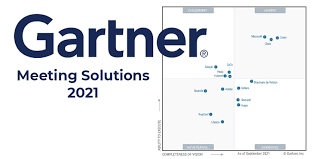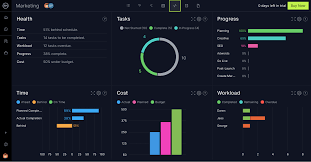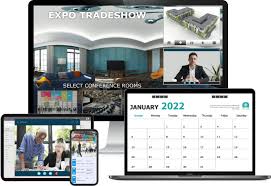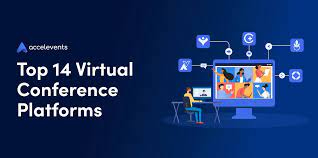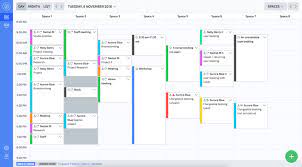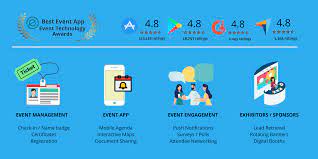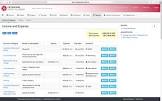Trade Show Software: Streamlining Success in the Exhibition Industry
In the fast-paced world of trade shows and exhibitions, staying organized and efficient is essential for success. That’s where trade show software comes into play. With its advanced features and capabilities, this technology has revolutionized the way businesses plan, manage, and execute their exhibition strategies.
Trade show software offers a wide range of tools designed to streamline various aspects of the exhibition process. From pre-event planning to post-event analysis, these software solutions provide comprehensive support, helping businesses maximize their return on investment and achieve their marketing goals.
One of the key features of trade show software is its ability to simplify registration and attendee management. With online registration portals, exhibitors can easily collect attendee information, track registrations, and generate personalized badges or tickets. This not only saves time but also enhances the overall attendee experience by reducing long queues and paperwork.
Furthermore, trade show software enables exhibitors to effectively manage booth assignments and floor plans. Through intuitive interfaces, exhibitors can view available booth spaces, select preferred locations based on traffic flow or competitor placement, and even visualize their booth design in a virtual environment. This level of control ensures that businesses make informed decisions about their exhibition space allocation, maximizing visibility and attracting potential customers.
During the event itself, trade show software facilitates lead capture and management. Exhibitors can use mobile apps or scanning devices to capture contact information from interested attendees quickly. These leads are then automatically organized within a centralized database for easy follow-up after the event. By streamlining this process, businesses can efficiently nurture leads into valuable customers.
Additionally, trade show software often includes features for scheduling appointments with prospects or managing on-site meetings. This eliminates the need for manual coordination via emails or phone calls while ensuring that valuable face-to-face interactions are optimized during busy exhibition hours.
Post-event analysis is another crucial aspect of trade show software. By providing detailed analytics reports on key metrics such as booth traffic, lead conversion rates, and attendee engagement, businesses can evaluate their performance and make data-driven decisions for future events. This valuable insight helps exhibitors identify strengths, weaknesses, and areas for improvement, ultimately enhancing their overall exhibition strategy.
In conclusion, trade show software has become an indispensable tool for businesses in the exhibition industry. From simplifying registration processes to optimizing lead management and providing valuable analytics, this technology empowers exhibitors to achieve their goals efficiently. By embracing trade show software, businesses can stay ahead of the competition, deliver exceptional experiences to attendees, and drive tangible results from their exhibition efforts.
Benefits of Trade Show Software: Boosting Efficiency, Saving Costs, Increasing Visibility, Expanding Networking Opportunities, Enhancing Customer Service, and Uncovering Data Insights
- Improved efficiency
- Cost savings
- Increased visibility
- Enhanced networking opportunities
- Improved customer service
- More data insights
5 Drawbacks of Trade Show Software: Exploring High Costs, Lack of Flexibility, Complex Setup, Limited Support, and Security Concerns
- High Cost
- Lack of Flexibility
- Complex Setup Process
- Limited Support
- Security Concerns
Improved efficiency
Improved Efficiency: Streamlining Trade Show Management with Software Solutions
Trade shows are vibrant events that require meticulous planning, coordination, and execution. In this fast-paced environment, trade show software has emerged as a game-changer, offering a plethora of benefits to organizers and exhibitors alike. One significant advantage of utilizing trade show software is the improved efficiency it brings to the entire event management process.
From the initial stages of planning to the post-show follow-up, trade show software simplifies and streamlines various tasks. Gone are the days of relying on spreadsheets, paper forms, and manual processes. With trade show software at their disposal, organizers can efficiently manage crucial aspects such as registration, booth assignments, scheduling, lead capture, and data analysis.
The automation capabilities of trade show software significantly reduce administrative burdens. Online registration portals eliminate the need for manual data entry by allowing attendees to register themselves easily. This not only saves time but also minimizes errors or discrepancies in attendee information.
Furthermore, trade show software provides intuitive tools for managing booth assignments and floor plans. Organizers can visualize the layout of the event space digitally and allocate booths strategically based on factors like traffic flow or exhibitor preferences. This ensures optimal utilization of space while maximizing exhibitor visibility.
During the event itself, trade show software facilitates seamless lead capture and management. Exhibitors can utilize mobile apps or scanning devices to collect attendee information swiftly and accurately. By automating this process, valuable leads are captured in real-time and seamlessly integrated into a centralized database for efficient follow-up post-show.
Moreover, trade show software simplifies appointment scheduling and meeting management. Exhibitors can utilize integrated calendars or appointment setting features to coordinate meetings with prospects or clients during the event seamlessly. This eliminates confusion or double-booking while optimizing valuable face-to-face interactions.
Post-show analysis is another area where trade show software excels in improving efficiency. The software generates comprehensive analytics reports that provide valuable insights into attendee engagement, booth traffic, lead conversion rates, and other key metrics. This data empowers organizers to evaluate their performance objectively and make informed decisions for future events.
In conclusion, trade show software revolutionizes the way trade shows are organized and managed. By embracing these software solutions, organizers can enhance efficiency at every stage of the event – from planning to follow-up. The automation of tasks, streamlined processes, and access to valuable insights enable organizers and exhibitors to deliver exceptional experiences while maximizing their return on investment. With improved efficiency as a significant pro, trade show software has become an indispensable tool in the modern exhibition industry.
Cost savings
Cost savings: How Trade Show Software Revolutionizes Efficiency and Budgets
In the fast-paced world of trade shows and exhibitions, time is money. That’s why trade show software has become a game-changer for businesses looking to optimize their resources and streamline their processes. One significant advantage of this technology is its ability to generate cost savings by automating various tasks associated with trade show management.
Trade show software eliminates the need for manual registration processes, saving both time and money. With online registration portals, exhibitors can effortlessly collect attendee information, track registrations, and generate personalized badges or tickets. This automated system reduces administrative overheads and eliminates the costs associated with printing and distributing physical registration materials.
Additionally, trade show software simplifies the process of scheduling appointments with prospects or managing on-site meetings. By providing intuitive interfaces and centralized platforms, this technology removes the need for time-consuming coordination via emails or phone calls. Exhibitors can efficiently manage their meeting schedules, optimizing valuable face-to-face interactions while minimizing wasted time.
Furthermore, trade show software enables exhibitors to track leads seamlessly. With mobile apps or scanning devices, businesses can capture contact information from interested attendees quickly. These leads are then automatically organized within a centralized database for easy follow-up after the event. By automating lead tracking, businesses save valuable hours that would otherwise be spent manually inputting data into spreadsheets or CRM systems.
The cost savings offered by trade show software extend beyond operational efficiencies; they also contribute to better budget management. By reducing administrative tasks and eliminating manual processes, businesses can allocate their resources more effectively. These cost savings can be redirected towards other critical aspects of the exhibition strategy such as booth design enhancements, promotional materials, or targeted marketing campaigns.
Moreover, trade show software provides valuable analytics reports on key metrics such as booth traffic, lead conversion rates, and attendee engagement. This data-driven insight allows businesses to evaluate their performance objectively and make informed decisions for future events. By identifying areas for improvement, businesses can optimize their strategies and allocate resources more efficiently, ultimately leading to better return on investment.
In conclusion, trade show software offers substantial cost savings by automating processes such as registration, scheduling, and lead tracking. By eliminating manual tasks and streamlining operations, businesses can save valuable time and money. These cost savings can be reinvested in enhancing the overall exhibition experience or allocated towards other marketing initiatives. Embracing trade show software not only improves efficiency but also contributes to better budget management, ultimately driving greater success in the competitive world of trade shows and exhibitions.
Increased visibility
Trade Show Software: Boosting Visibility and Engagement Before the Event
In the competitive landscape of trade shows and exhibitions, standing out from the crowd is crucial. One significant advantage of trade show software is its ability to increase visibility for exhibitors even before the event kicks off. By leveraging this technology, businesses can create custom profiles and engage with attendees online, giving them a head start in capturing attention and generating interest.
With trade show software, exhibitors have the opportunity to create compelling profiles that showcase their products or services. These profiles act as virtual storefronts, allowing businesses to highlight their unique selling points and attract potential customers. Exhibitors can include detailed descriptions, high-quality images or videos, and relevant links to their websites or social media platforms. By crafting an enticing profile, exhibitors can pique attendees’ curiosity and entice them to learn more.
Engagement is another key element facilitated by trade show software. Through online platforms or dedicated event apps, exhibitors can interact with attendees even before they step foot on the exhibition floor. This engagement can take various forms such as sharing sneak peeks of new products or services, posting informative articles or videos related to their industry, or initiating discussions about industry trends and challenges.
By actively engaging with attendees prior to the event, exhibitors build anticipation and establish themselves as thought leaders in their respective fields. This early connection helps create a sense of familiarity between exhibitors and potential customers, making it more likely for attendees to seek out specific booths during the event.
Moreover, trade show software often provides features that facilitate direct communication between exhibitors and attendees. This may include options for messaging or scheduling appointments in advance. By leveraging these tools effectively, exhibitors can nurture relationships with interested prospects before meeting face-to-face at the event. This personalized approach enhances attendee experience while increasing the chances of meaningful interactions that lead to valuable business opportunities.
Overall, increased visibility is a significant pro of trade show software. By utilizing this technology to create compelling profiles and engage with attendees online before the event, exhibitors can capture attention, generate interest, and establish meaningful connections. This proactive approach not only boosts visibility but also sets the stage for successful interactions during the actual exhibition. For businesses aiming to make a lasting impression at trade shows, trade show software is a valuable tool that should not be overlooked.
Enhanced networking opportunities
Enhanced Networking Opportunities: Building Connections with Trade Show Software
In the world of business, networking is crucial for building relationships and uncovering new opportunities. Traditionally, trade shows have been a prime platform for connecting with potential partners, clients, and industry professionals. Now, with the advent of trade show software, networking has reached new heights.
One significant advantage of trade show software is its ability to enhance networking opportunities for exhibitors. This technology provides an easy and efficient way for exhibitors to connect with each other before, during, and after the event, fostering valuable relationships that could lead to future business collaborations.
Before the event even begins, trade show software allows exhibitors to browse through attendee lists and profiles. This feature enables businesses to identify potential prospects or partners that align with their objectives or target audience. By having access to this information in advance, exhibitors can plan their networking efforts strategically and make meaningful connections right from the start.
During the event itself, trade show software provides various tools that facilitate networking interactions. Many platforms offer features like virtual chat rooms or matchmaking algorithms that suggest relevant connections based on shared interests or goals. Exhibitors can reach out to each other through these platforms, schedule meetings or demos in advance, and make the most of their time on the exhibition floor.
Moreover, some trade show software includes mobile apps that enable real-time communication between exhibitors. These apps often have features like messaging systems or social feeds where attendees can engage in discussions or share updates about their products and services. Such interactive platforms create a dynamic environment conducive to building connections and fostering collaboration among participants.
Even after the event concludes, trade show software continues to play a vital role in nurturing networking opportunities. Exhibitors can use these platforms to follow up with contacts they made during the event by sending personalized messages or sharing relevant resources. This seamless post-event communication helps solidify relationships formed at the exhibition and keeps potential business opportunities alive.
By leveraging trade show software’s enhanced networking capabilities, exhibitors can expand their professional networks, forge valuable partnerships, and open doors to future business endeavors. The ease of connecting with like-minded individuals in the industry not only accelerates the growth of a business but also fosters a sense of community and collaboration within the exhibition space.
In conclusion, trade show software has revolutionized networking in the exhibition industry. By providing exhibitors with powerful tools to connect before, during, and after events, this technology enhances networking opportunities like never before. Exhibitors can build meaningful relationships, discover new prospects or partners, and ultimately create a network that propels their business forward. Embracing trade show software is a game-changer for exhibitors seeking to expand their horizons and unlock a world of possibilities.
Improved customer service
Enhancing Customer Service with Trade Show Software
In the fast-paced environment of trade shows and exhibitions, providing exceptional customer service is crucial for exhibitors. With the advent of trade show software, exhibitors now have a powerful tool at their disposal to elevate their customer service game to new heights.
One significant advantage of trade show software is its ability to improve customer service through real-time communication channels. Exhibitors can integrate chat or video conferencing tools directly into the software platform, enabling them to respond promptly to attendee questions or concerns during the event.
Gone are the days of waiting in long lines or struggling to find a representative amidst a bustling exhibition hall. With trade show software, attendees can simply initiate a chat or video call with exhibitors from their mobile device or computer. This instant connection allows exhibitors to address queries or resolve issues in real-time, ensuring attendees receive immediate assistance and support.
The integration of chat or video conferencing tools within trade show software not only enhances convenience but also fosters a more personalized and engaging customer experience. Attendees can have meaningful conversations with exhibitors, ask specific questions about products or services, and receive tailored recommendations based on their needs. This level of interaction builds trust and rapport between exhibitors and attendees, ultimately leading to stronger relationships and potential business opportunities.
Moreover, by leveraging trade show software’s real-time communication capabilities, exhibitors can showcase their commitment to exceptional customer service. Attendees will appreciate the responsiveness and attentiveness exhibited by exhibitors who utilize these tools effectively. This positive impression can leave a lasting impact on attendees’ perception of the brand and increase the likelihood of future engagement or purchases.
Additionally, trade show software allows for efficient collaboration among team members working at different booths or locations within an exhibition hall. Exhibitor staff can communicate seamlessly through internal messaging systems within the software platform, ensuring quick coordination and sharing of information. This streamlined internal communication translates into improved customer service as staff members can access real-time updates, share knowledge, and provide consistent responses to attendee inquiries.
In conclusion, trade show software has revolutionized customer service in the exhibition industry. By integrating chat or video conferencing tools into the platform, exhibitors can offer prompt and personalized assistance to attendees during the event. This not only enhances convenience but also builds stronger relationships and leaves a positive impression on attendees. With trade show software, exhibitors can elevate their customer service game and create memorable experiences that drive customer satisfaction and business success.
More data insights
Unlocking Valuable Insights: How Trade Show Software Enhances Data Analytics
One of the significant advantages of utilizing trade show software is the ability to gather and analyze valuable data about attendees. Trade shows provide a unique opportunity to interact with a diverse audience and gain insights into their interests, preferences, and behaviors. With the analytics capabilities offered by trade show software, businesses can harness this data to inform their future marketing efforts effectively.
By leveraging trade show software’s analytics features, exhibitors can collect and analyze attendee data in a more structured and organized manner. This includes information such as demographics, contact details, booth visits, session attendance, and even engagement with specific products or services. Such comprehensive data empowers businesses to better understand their target audience and tailor their marketing strategies accordingly.
The analytics capabilities of trade show software allow for in-depth analysis and reporting of key metrics. Exhibitors can gain insights into attendee foot traffic patterns, popular booth areas, peak visiting times, and other valuable statistics. This information helps identify which aspects of an exhibition were successful and which areas may need improvement in future events.
Moreover, trade show software enables exhibitors to track lead generation and conversion rates accurately. By capturing leads through various interactions at the event – from scanning badges to collecting contact information – businesses can measure the effectiveness of their exhibition efforts. These insights help them evaluate the return on investment (ROI) from participating in specific trade shows or implementing particular marketing strategies.
The data gathered from trade show software also contributes to building robust customer profiles. By analyzing attendees’ interests, preferences, and engagement levels at the event, businesses can create more targeted and personalized marketing campaigns post-event. This valuable knowledge allows for effective segmentation and customization of messaging based on attendees’ specific needs or pain points.
Furthermore, by integrating trade show software with existing customer relationship management (CRM) systems or marketing automation platforms, businesses can centralize all collected data for seamless synchronization across various channels. This integration enables a holistic view of attendees’ interactions, both online and offline, providing a complete understanding of their journey and enabling more personalized and effective follow-up communication.
In conclusion, trade show software’s analytics capabilities unlock a wealth of valuable insights for businesses. By utilizing the data gathered from trade shows, exhibitors can make informed decisions about their future marketing efforts. The ability to understand attendee interests, preferences, and behaviors allows for targeted messaging and enhanced customer experiences. With trade show software, businesses can leverage data analytics to optimize their exhibition strategies and drive successful marketing campaigns in the future.
High Cost
High Cost: A Trade-Off for Trade Show Software
While trade show software offers numerous benefits and efficiencies, it’s important to consider the potential drawbacks as well. One significant con of trade show software is its high cost, often requiring a substantial upfront investment.
Trade show software solutions typically come with a price tag that includes licensing fees, implementation costs, and ongoing maintenance expenses. For businesses operating on tight budgets or those just starting out in the exhibition industry, these costs can be prohibitive.
The initial investment required for trade show software may pose a challenge for small businesses or organizations with limited resources. Allocating a significant portion of the budget to software expenses might mean compromising on other essential aspects of an exhibition strategy, such as booth design, marketing collateral, or promotional activities.
Moreover, some trade show software providers charge additional fees for premium features and add-ons. These optional functionalities might be enticing but can further increase the overall cost of using the software. It’s crucial to carefully evaluate whether these extras are truly necessary or if they can be managed through alternative means.
However, it is important to note that while the upfront cost may seem high initially, trade show software can offer significant long-term benefits and return on investment. By streamlining processes and improving efficiency throughout all stages of an exhibition, businesses can potentially save time and resources in the long run.
To mitigate the financial burden associated with trade show software, businesses should consider thoroughly researching different providers and their pricing models. Comparing features and pricing structures will help identify options that align with specific needs and budgetary constraints. Additionally, exploring alternative solutions such as open-source or cloud-based platforms may present more affordable options without compromising functionality.
Ultimately, while high costs are a valid con of trade show software, businesses should carefully weigh these expenses against the potential benefits provided by the technology. Conducting a thorough cost-benefit analysis will help determine whether investing in trade show software is financially viable and aligns with the organization’s overall exhibition strategy.
Lack of Flexibility
Lack of Flexibility: A Con of Trade Show Software
While trade show software offers numerous benefits and streamlines various aspects of the exhibition process, it’s important to acknowledge that there can be downsides as well. One significant drawback is the lack of flexibility that some trade show software programs exhibit when it comes to adapting to changing needs or preferences.
Trade shows and exhibitions are dynamic events that often require adjustments on the fly. Exhibitors may need to modify booth layouts, change schedules, or update attendee information at a moment’s notice. However, certain trade show software solutions may not provide the necessary flexibility to accommodate these changes efficiently.
One common issue is the limited customization options available within the software. Exhibitors may find themselves restricted by predetermined templates or rigid workflows that do not align with their specific requirements. This lack of flexibility can be frustrating and hinder exhibitors from tailoring their exhibition strategies to meet their unique goals.
Moreover, some trade show software programs may not integrate seamlessly with other tools or systems that exhibitors rely on for their overall event management. This lack of integration can result in data silos, manual data entry processes, or even compatibility issues between different software platforms. These challenges can lead to inefficiencies and potential errors in information management.
Additionally, as technology advances and new features become available, exhibitors may desire additional functionalities from their trade show software. However, upgrading or expanding existing software capabilities might not always be possible due to limitations imposed by the provider. This lack of scalability can hinder businesses from fully leveraging emerging technologies or adapting to evolving industry trends.
To mitigate these issues, it’s crucial for businesses considering trade show software solutions to thoroughly evaluate the flexibility and adaptability offered by different providers. Seeking customizable options, integration capabilities, and scalability should be a priority during the selection process.
In conclusion, while trade show software provides numerous advantages in streamlining exhibition management processes, its lack of flexibility can pose challenges for businesses. Being aware of this con and carefully assessing the software’s adaptability to changing needs or preferences is essential to ensure a seamless and efficient exhibition experience.
Complex Setup Process
Complex Setup Process: A Hurdle to Overcome in Trade Show Software
While trade show software offers numerous benefits and streamlines various aspects of the exhibition process, it’s important to acknowledge that there can be a con associated with its implementation. One potential drawback is the complex setup process that often accompanies trade show software.
Setting up trade show software can be a daunting task, especially for those without technical expertise or experience in configuring such programs. It typically requires a thorough understanding of the software’s functionalities and features, as well as knowledge of the specific requirements and nuances of the exhibition industry.
The complexity of the setup process can pose challenges for businesses, particularly small or inexperienced exhibitors who may not have dedicated IT resources or personnel available. Without proper guidance or support, they may struggle to navigate through the initial configuration steps and encounter difficulties in optimizing the software for optimal performance.
Moreover, the time required for setting up trade show software should not be underestimated. It often involves multiple steps, including data migration, customization of settings, integration with existing systems (such as CRM platforms), and training staff on how to effectively use the software. This can lead to delays in getting up and running smoothly, potentially impacting overall productivity and efficiency during crucial pre-event preparations.
However, it’s important to note that while the setup process may initially present challenges, many trade show software providers offer comprehensive customer support and training resources to assist businesses throughout this phase. They understand that not all users are tech-savvy and strive to simplify the setup process as much as possible.
By providing user-friendly interfaces, step-by-step guides, video tutorials, and responsive customer service teams, these providers aim to alleviate any complexities associated with setting up their software. Additionally, some even offer on-site assistance during critical stages of implementation or provide dedicated account managers who can guide users through the setup process.
It’s also worth mentioning that once trade show software is properly set up and configured, the benefits it offers can outweigh the initial challenges. The software’s advanced features and capabilities can significantly enhance efficiency, streamline processes, and ultimately contribute to a successful exhibition experience.
In conclusion, while the complex setup process of trade show software may present a temporary hurdle, it should not discourage businesses from exploring its potential benefits. With the right support from software providers and a willingness to invest time and effort into the setup phase, exhibitors can overcome this con and unlock the full potential of trade show software in achieving their exhibition goals.
Limited Support
Limited Support: A Drawback of Trade Show Software
While trade show software offers numerous advantages for businesses in the exhibition industry, it’s important to acknowledge that there can be some downsides as well. One notable drawback is the limited support options that often come with this type of software.
When using trade show software, it’s not uncommon for users to encounter technical issues or have questions about certain features. However, the availability of reliable and timely support can vary from one software provider to another. Some providers may offer only basic documentation or online resources, leaving users to troubleshoot problems on their own.
This lack of comprehensive support can be frustrating, especially for exhibitors who are new to using trade show software or those who encounter complex issues that require expert assistance. Without readily available support channels such as phone or live chat support, resolving problems can become time-consuming and may hinder productivity during critical stages of event planning or execution.
Moreover, limited support options can also impact the learning curve for users who are unfamiliar with the software. While some platforms may provide training materials or tutorials, having direct access to knowledgeable support staff can greatly expedite the learning process and ensure a smooth user experience.
To mitigate this con, it is advisable for businesses considering trade show software to thoroughly research and evaluate the level of customer support offered by different providers. Look for companies that provide comprehensive assistance through multiple channels like phone, email, live chat, or even on-site support during events. Additionally, reading reviews from other users and seeking recommendations from industry peers can help gauge the quality of customer service provided by different software vendors.
In conclusion, while trade show software brings undeniable benefits to businesses in terms of efficiency and organization during exhibitions, it’s crucial to be aware of potential limitations in terms of customer support. By carefully selecting a reputable provider that offers robust and accessible support options, businesses can minimize any potential challenges associated with troubleshooting issues and maximize their overall experience with trade show software.
Security Concerns
Security Concerns: Protecting Your Trade Show Software
While trade show software offers numerous benefits, it’s essential to address the potential security concerns associated with these digital solutions. Like any other technology, trade show software can be vulnerable to security breaches and data loss if not properly protected.
One of the primary concerns is the risk of unauthorized access to sensitive information. Exhibitors often collect valuable data during trade shows, including attendee contact details, business proposals, and sales leads. If this information falls into the wrong hands, it can have serious consequences for both the exhibitor and attendees.
To mitigate these risks, it’s crucial for exhibitors to prioritize security measures. This includes working closely with their IT team or external experts to implement robust security protocols. Encryption technology can be employed to protect sensitive data by converting it into a code that is unreadable without the appropriate decryption key. Firewalls act as a barrier between internal networks and external threats, preventing unauthorized access.
Additionally, exhibitors should ensure that trade show software providers follow industry best practices for data protection. This includes regular software updates and patches to address any vulnerabilities that may arise over time. It’s important to choose reputable providers who prioritize security and have a track record of implementing strong security measures.
Furthermore, exhibitors should educate their staff on best practices for using trade show software securely. This may include training on password management, recognizing phishing attempts or suspicious links, and adhering to company policies regarding data handling.
By taking these precautions, exhibitors can significantly reduce the risk of security breaches or data loss associated with trade show software. While no system is entirely foolproof, implementing comprehensive security measures helps protect valuable information and maintain trust with both attendees and stakeholders.
In conclusion, while there are potential security concerns associated with trade show software, they can be effectively managed through proactive measures. By working closely with IT teams or external experts, implementing encryption technology and firewalls, choosing reputable providers, and educating staff on security best practices, exhibitors can safeguard their data and ensure a secure trade show experience for all involved.

